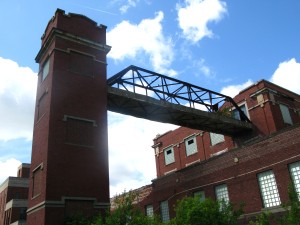 Our first full day of urban exploration in Flint turned out to be quite eventful. After a quick dip in the lake at our campground, we headed out to a decommissioned and long-vacant water treatment plant on the outskirts of the city. What we found when we got there was an eerily quiet, lonely shell of what was once a quite dignified example of an industrial complex. The old building’s brick facade, with its collection of broken window panes and welded-shut doors does little to convey the level of decay we found inside.
Our first full day of urban exploration in Flint turned out to be quite eventful. After a quick dip in the lake at our campground, we headed out to a decommissioned and long-vacant water treatment plant on the outskirts of the city. What we found when we got there was an eerily quiet, lonely shell of what was once a quite dignified example of an industrial complex. The old building’s brick facade, with its collection of broken window panes and welded-shut doors does little to convey the level of decay we found inside.
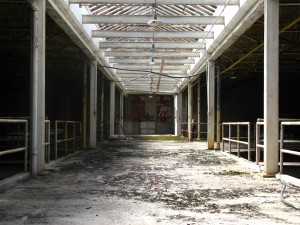 Rooms full of forgotten equipment, standing amidst puddles of stagnant water and piles of glass, rubble and junk greeted us inside the plant. A long room with enormous empty water tanks on either side of the room was found filled with sunlight pouring in through the skylights that ran down the center of the ceiling. The lower level, with its huge assortment of bulky machinery was flooded with several feet of water. What looked to be an office/filing room at one time was now nothing more than a collection of bookshelves with heaps and heaps of rotting folders and binders on it. Graffiti marked most of the walls – cryptic messages left years ago? days ago? The only sounds beside our footsteps crunching over the mix of debris on the floor were that of pigeons living in the rafters and the distant swooshing noise of traffic.
Rooms full of forgotten equipment, standing amidst puddles of stagnant water and piles of glass, rubble and junk greeted us inside the plant. A long room with enormous empty water tanks on either side of the room was found filled with sunlight pouring in through the skylights that ran down the center of the ceiling. The lower level, with its huge assortment of bulky machinery was flooded with several feet of water. What looked to be an office/filing room at one time was now nothing more than a collection of bookshelves with heaps and heaps of rotting folders and binders on it. Graffiti marked most of the walls – cryptic messages left years ago? days ago? The only sounds beside our footsteps crunching over the mix of debris on the floor were that of pigeons living in the rafters and the distant swooshing noise of traffic.
What was this place like in its prime – when it was fully operational and filled with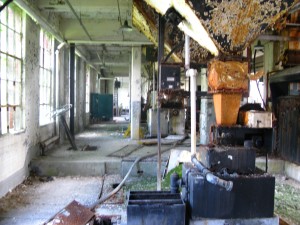 workers, when tons and tons of water cycled through it on its way from the Flint River to the city’s water supply? What might this place have become if someone had thought to rescue it before time and nature swept in to reclaim it? Might this place still have some kind of chance, no matter how unlikely, to become something altogether different than a water treatment plant? Is there a new life for this building lurking deep within its flooded and silent interior? Or has the building already found new life through its death – has it become, once again, an inseparable part of the landscape that surrounds it?
workers, when tons and tons of water cycled through it on its way from the Flint River to the city’s water supply? What might this place have become if someone had thought to rescue it before time and nature swept in to reclaim it? Might this place still have some kind of chance, no matter how unlikely, to become something altogether different than a water treatment plant? Is there a new life for this building lurking deep within its flooded and silent interior? Or has the building already found new life through its death – has it become, once again, an inseparable part of the landscape that surrounds it?
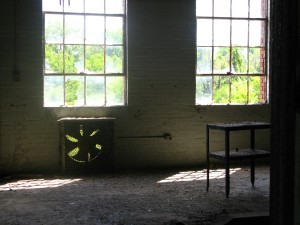 Wildflowers and grass have snuck right up to the buildings walls – the roof has sprouted a variety of wild plants – moss has begun to cover interior brick walls – birds nest in it – a hawk hunts for food in the wide open meadow on the backside of the plant – this is one of the landscapes that has replace what was once a vast, vibrant industrial landscape. Rust and nature now reign supreme here.
Wildflowers and grass have snuck right up to the buildings walls – the roof has sprouted a variety of wild plants – moss has begun to cover interior brick walls – birds nest in it – a hawk hunts for food in the wide open meadow on the backside of the plant – this is one of the landscapes that has replace what was once a vast, vibrant industrial landscape. Rust and nature now reign supreme here.
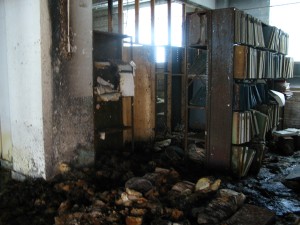 As we continue on our trip, documenting the new landscapes to be found throughout the Rustbelt of Michigan, we will continue to wonder to ourselves – What were these places once like? What has become of them? Have they found a new and different life? We hope that, through our efforts to simply to find what’s out there and to document it, that others will begin to wonder these same thoughts and that a dialogue might then be started.
As we continue on our trip, documenting the new landscapes to be found throughout the Rustbelt of Michigan, we will continue to wonder to ourselves – What were these places once like? What has become of them? Have they found a new and different life? We hope that, through our efforts to simply to find what’s out there and to document it, that others will begin to wonder these same thoughts and that a dialogue might then be started.
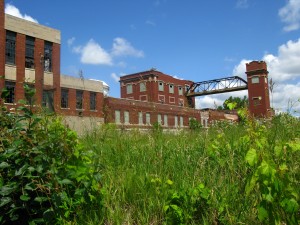 We would love comments on all this – so if you have any thoughts, let us know.
We would love comments on all this – so if you have any thoughts, let us know.
-Jamie

enjoying your posts on Flint.
You should get HGTV into places like this to clean it up, put in nice landscaping, and then auction it off for people to live! If it can really be clean enough …
Or what about youth hostiles? But who would want to vacation there …
An airport?
I am out of ideas.
OH. COVER IT WITH SOLAR PANELS. USE ALL OF THE DESERTED BUILDINGS AS A PLATFORM FOR NEW, REUSABLE ENERGY! Then you can have solar panels, windmills, etc. in all of the places that no one is using to generate some sort of good from the Rusty Mitten.
OR, work on public transit through the state. Fast trains through these areas?
I like your website. Hopefully you can help Michigan. Maybe Michigan can help the world!
I particularly like the “youth hostiles” idea. Such an appropriate concept for some locales.
I like it that smart young people are interested in the cities of the rust belt and what will become of them. I grew up in Flint, and have also lived in Saginaw and Cleveland. Now I live in Ypsilanti.
I could comment on your blog all night, but I’m going to restrict myself right now to mentioning that I don’t believe the water treatment plant you visited ever produced drinking waterfor Flint. I think Flint’s drinking water has always come from Lake Huron — from the same plants that produce Detroit’s water.
The lakes are why the cities exist where they exist, of course. Iron ore came down the lakes from the Upper Peninsula, and was used in every large and small industrial city on the Great Lakes: Green Bay, Milwaukee, Chicago, Saginaw, Detroit, Toledo, Cleveland, Erie and Buffalo; as well as the inland satellites where related manufacturers set up shop: Gary, Grand Rapids and Lansing, and, of course, Flint.
These are the cities that mobilized instantly to produce the weapons that won World War II (the Ford Willow Run plant near Ypsi produced 8,700 B-24 bombers, and employed over 42,000 people — many women — during peak war production).
That America hasn’t found a way to salvage something of value from these places that built the 20th century says a lot about our collective memory, our loyalty, our rejection of a future based on anything but the basest consumerist values, and our nearly religious commitment to always being a transient culture.
We never reuse anything sensibly. We just throw out the old and let it rot. Or rust.
very interesting and informative post! i LOVE the 1st, 2nd, and 5th photos. sounds like a fun day! where exactly is this located? i lived near flint (grand blanc) for almost 20 years and never even heard of this place. i’m assuming it’s somewhere near the river?